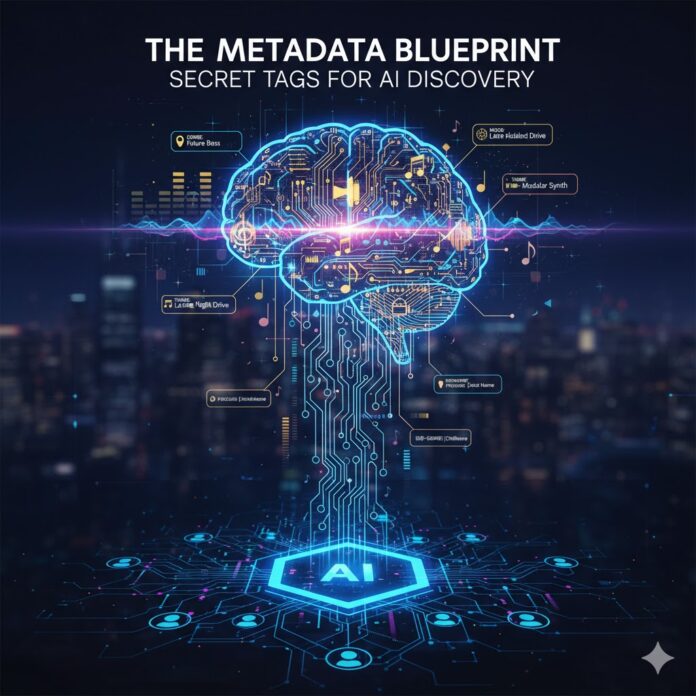
🎧 The Metadata Blueprint: Secret Tags That Tell AI Exactly Who Your Music Is For
In the modern music landscape, your music’s journey from your distributor to a listener’s ears is increasingly governed by AI and complex algorithms. Forget just the title and artist name; the backend metadata of your music release—those “secret tags”—is the true key to unlocking algorithmic discovery and maximizing your stream count.
This is a technical deep dive into optimizing the hidden fields in your distributor’s dashboard to prime your track for algorithmic similarity grouping. Get this right, and you’re giving the AI a blueprint of your perfect fan.
🎯 The Algorithmic Goal: Similarity Grouping
Streaming platforms (DSPs) like Spotify, Apple Music, and Amazon Music rely on sophisticated recommendation engines. These engines’ core function is algorithmic similarity grouping: finding users who like music similar to yours.
This similarity isn’t just about sonic characteristics; it’s heavily influenced by the descriptive and administrative metadata you provide. The algorithm uses this data to quickly categorize your track and test it with relevant listener groups, which, in turn, fuels its machine-learning feedback loop.
Why Standard Metadata Isn’t Enough
Every track has Required Metadata (Title, Artist, ISRC, etc.). But the true power lies in the Optional/Descriptive Tags many artists overlook. These are the fields that turn a generic “Pop Song” into “A late-night, melancholic, synth-driven indie pop track about city life.”
🔑 Your Secret Tag Arsenal: Deep-Dive Metadata Fields
Maximizing your algorithmic potential means treating your distributor’s submission form as a hyper-targeted SEO strategy.
1. The Genre/Sub-Genre Hierarchy
Don’t settle for “Electronic.” Go deeper. Most distributors allow for a Primary and Secondary genre.
- Primary: Electronic (Broad search/categorization)
- Secondary: Future Bass or Chillwave (Niche algorithmic grouping)
The AI Advantage: By providing a specific sub-genre, you immediately place your track in a smaller, highly relevant cluster of music, increasing the chance of being included in niche algorithmic playlists (e.g., “Deep Focus Beats”).
2. Mood, Theme, and Vibe Tags
These are perhaps the most critical descriptive tags for playlist and radio generation algorithms. Be accurate and extensive.
- Mood: Energetic, Melancholy, Uplifting, Chill, Aggressive
- Theme: Road Trip, Workout, Study, Late Night Drive, Nostalgia, Love
- Vibe: Atmospheric, Minimalist, Heavy, Acoustic
Technical Tip: Some distributors have dedicated fields, while others rely on a “Description” or “Keywords” box. If you have a freeform box, use commas to separate a long list of highly specific, one-word descriptors that accurately capture the feel of the music.
3. Instrumental Roles and Contributors (The Credit Tag)
Algorithms use contributor data to connect artists who share a similar sound team. Crediting your Producers, Mix/Mastering Engineers, Composers, and Lyricists is vital.
- Composer/Lyricist: This links your work to the recorded track, essential for royalty collection and for AI to group your songs together even if the artist name is a feature on a different track.
- Instrumental Roles: Explicitly tag unusual instrumentation (e.g., Sitar, Modular Synth, 808 Drum Machine). This allows an algorithm to group your track with other music featuring that unique sonic signature, even across genres.
Pro-Move: If a famous engineer or producer worked on your track, their name is an AI breadcrumb connecting your track to their existing, successful body of work.
📝 Best Practices for AI-Proofing Your Metadata
Getting your tags right isn’t just about filling boxes; it’s about adhering to the unwritten rules of the DSPs to avoid being flagged or filtered.
| Practice | Actionable Step | Algorithmic Benefit |
| Consistency | Use the exact same name for artist, track, and collaborators across all platforms (Spotify, YouTube, Instagram, etc.). | Prevents your music from being misidentified as another artist’s, ensuring all streams count towards your profile. |
| NO Keyword Stuffing | NEVER use phrases like “Sleep Music 2025,” “Top Hits,” or uncredited artist names in your Title or Artist fields. DSPs actively punish this violation of their Content Style Guidelines and may remove your track. | Avoids algorithmic penalty; ensures your track is taken seriously by editorial curators. |
| Version Accuracy | Clearly define the version of the track: Radio Edit, Album Version, Remix, Acoustic. Use the dedicated field, not the main title. | Informs algorithms about the track’s purpose and length (e.g., Radio Edits are shorter and better for radio-like features). |
| Explicit Tag | Use the mandatory “Explicit” or “Clean” tag. Do not write “(Explicit)” in the title. | Correctly filters content for listeners with different preferences and adheres to DSP rules. |
| Language Tag | Correctly specify the language of the lyrics (or ‘Instrumental’). | Crucial for regional and language-specific playlisting and search results. |
🚀 The Backend Payoff: Your Discovery Loop
By meticulously crafting your metadata blueprint, you move from relying on random luck to a targeted algorithmic push.
- Precise Tagging: You clearly define your track’s characteristics (Mood: Wistful, Genre: Indie Folk, Instrument: Mandolin).
- Algorithmic Grouping: The AI places your track in highly relevant similarity clusters (e.g., “Artists who sound like [Your Inspiration] and use a Mandolin”).
- Targeted Testing: Your music is tested via Radio, Daily Mixes, and Discovery Mode with the perfect, pre-qualified listener.
- High Engagement: Because the match is accurate, listeners skip less, save more, and listen longer. This positive engagement data tells the AI your track is a hit within that specific cohort.
- Viral Expansion: The algorithm scales up the promotion of your track to an ever-wider audience who share those initial similarity characteristics.
Your metadata is not just paperwork; it’s the instruction manual for the machine that powers music discovery. Invest the time in the backend, and watch the AI turn your tags into streams.





















 🔥 Limited Time: Get 55% OFF All Plans - Ends in:
🔥 Limited Time: Get 55% OFF All Plans - Ends in: